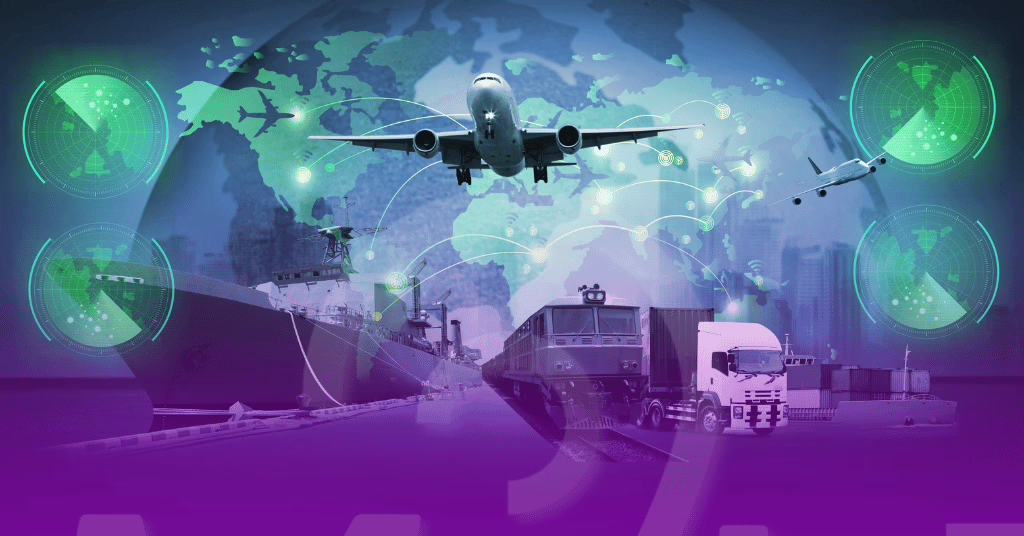في مجال الخدمات اللوجستية، لا تأتي انبعاثات الغازات المسببة للانحباس الحراري من مصدر واحد فقط. بل يتم إطلاقها في كل خطوة من خطوات رحلة المنتج من مصنع التصنيع وحتى شرفة العميل.
وإذا أضفنا إلى ذلك النمو السريع للتجارة الإلكترونية، فإن التأثير البيئي للخدمات اللوجستية يتضاعف بشكل كبير. والسبب بسيط: فمع زيادة التسوق عبر الإنترنت، يزداد الطلب على عمليات التسليم السريعة والمتكررة. دراسة جديدة للمنتدى الاقتصادي العالمي وقد وجد الباحثون أن نمو التجارة الإلكترونية وحده قد يؤدي إلى ارتفاع انبعاثات الكربون المرتبطة بالتوصيل بمقدار 331 طنًا سنويًا بحلول عام 2030 وإطلاق حوالي 3.1 مليار طن إضافي من ثاني أكسيد الكربون في الغلاف الجوي. وباعتبارنا متسوقين عبر الإنترنت، فإن هذه تكلفة بيئية ضخمة ندفعها مقابل الراحة، خاصة عندما لا تأخذ ممارسات اللوجستيات التقليدية في الاعتبار الاستدامة.
إن طرق التسليم الأطول من اللازم، والمركبات القديمة ذات الاستهلاك المرتفع للوقود، وخطط التسليم غير المحسنة، كلها تؤدي إلى أميال إضافية، ووقود إضافي، وانبعاثات إضافية. وتوضح هذه الاختلالات في الكفاءة لماذا من المهم للغاية أن تعيد شركات الخدمات اللوجستية النظر في نهجها فيما يتعلق بطرق التسليم.
ولحسن الحظ، فإن الدفع نحو الاستدامة في مجال الخدمات اللوجستية لا يأتي من الشركات فحسب، بل من الحكومات والمستهلكين أيضًا. اتفاقية باريسعلى سبيل المثال، هناك التزام عالمي بالحد من ارتفاع درجة الحرارة العالمية إلى أقل من 2 درجة مئويةونتيجة لذلك، أصبحت الحكومات تحاسب الشركات على تحقيق هذه الأهداف، وتطالبها بإعادة التفكير في تأثيرها البيئي وإيجاد طرق للحد من الانبعاثات وتنفيذ ممارسات أكثر خضرة.
وفي استجابة لذلك، تتجه العديد من شركات الخدمات اللوجستية إلى التكنولوجيا لإيجاد الحلول. وتتمثل إحدى الخطوات الأولى في تنفيذ استراتيجيات التخطيط المستدام للمسارات، التي تستخدم البيانات في الوقت الفعلي وخوارزميات التوجيه المتقدمة لرسم خرائط لطرق التسليم التي تقلل من المسافة المقطوعة بالسيارة واستهلاك الوقود.
عندما يتم تحسين طرق التسليم، يصبح عدد المركبات على الطريق أقل، والانبعاثات أقل، وعمليات التسليم أسرع. كما بدأت بعض الشركات في استخدام المركبات الكهربائية أو الهجينة للتوصيل في المناطق الحضرية والميل الأخير. والمركبات الكهربائية، على وجه الخصوص، لا تنتج أي انبعاثات من العوادم، وهي الحل الأمثل للحد من البصمة الكربونية في المناطق المكتظة بالسكان.
فوائد استراتيجيات تحسين المسار المستدام
على عكس الاعتقاد الخاطئ الشائع بأن الممارسات الصديقة للبيئة مكلفة، فإن تحسين المسار المستدام هو في الواقع استثمار ذكي يحقق فوائد عملية، سواء من الناحية المالية أو البيئية.
فيما يلي ملخص لما نعني عندما نقول إن تحسين المسار المستدام يؤدي إلى انخفاض التكاليف، وزيادة سعادة العملاء، وتحسين سمعة العلامة التجارية، ومكانة أقوى في السوق.
توفير التكاليف
هذه هي الفائدة الأكبر والأكثر مباشرة على الأرجح لتحسين المسارات المستدامة. عندما تقلل الشركات المسافة التي تحتاجها المركبات للسفر وتجنب المناطق ذات حركة المرور الكثيفة، ينخفض استهلاكها للوقود تلقائيًا. يمكن أن يؤدي هذا التخفيض إلى خفض تكاليف الوقود بما يصل إلى 20%، وهو توفير كبير للشركات التي تعتمد على أساطيل المركبات الكبيرة للخدمات اللوجستية. أيضًا، عندما تقضي المركبات وقتًا أقل على الطريق، فإنها تتآكل وتتلف بشكل أقل، وبالتالي توفر الشركات تكاليف الصيانة وتطيل عمر المركبة. تؤثر تخفيضات التكلفة هذه بشكل مباشر على صافي أرباح الشركة- دليل واضح إن الممارسات المستدامة يمكن أن تكون مربحة للغاية أيضًا.
سمعة العلامة التجارية الإيجابية
يهتم المستهلكون اليوم بالبيئة أكثر من أي وقت مضى، وهم يختارون بشكل متزايد دعم الشركات التي تشاركهم قيمهم. عندما تتبنى الشركات تحسين المسار المستدام، فإنها تُظهر التزامها بتقليص بصمتها الكربونية�� وتجذب عملاء جددًا يرغبون في دعم الشركات الخضراء، كما تبني الولاء لدى العملاء الحاليين الذين يقدرون تركيزها على الاستدامة. المنافسة الشديدة هي سمة أساسية للاقتصاد الرقمي اليوم. إن اكتساب سمعة طيبة في الممارسات الصديقة للبيئة يمكن أن يميز أي عمل تجاري حقًا ويشجع على الكلام الإيجابي وتكرار العمل.
الامتثال التنظيمي
مع تشديد العديد من الحكومات للقواعد البيئية، أصبحت الشركات التي تستثمر في الممارسات المستدامة في وضع أفضل للامتثال للقواعد الجديدة. تساعد استراتيجيات تحسين المسار المستدام الشركات على تلبية معايير الانبعاثات وتجنب العقوبات المرتبطة بالإفراط في إنتاج الغازات المسببة للانحباس الحراري العالمي. وعلاوة على ذلك، تقدم بعض المناطق حوافز، مثل الإعفاءات الضريبية أو المنح، للشركات التي تعمل بنشاط على تقليل بصمتها البيئية. ومن خلال التوافق مع هذه المعايير، يمكن للشركات قتل عصفورين بحجر واحد: تجنب المتاعب التنظيمية والاستفادة من الحوافز المالية المحتملة.
زيادة رضا العملاء
يضمن لك تحسين المسار المستدام التخطيط لمسارات أسرع وأكثر مباشرة. يمكن لعملائك أن يثقوا بك أكثر فيما يتعلق بسرعة التسليم والالتزام بالمواعيد. هذا المستوى من الخدمة يجعلهم سعداء، حيث يتلقون طرودهم في الوقت المحدد، مع الحد الأدنى من التأخير الناجم عن التحويلات أو الازدحام الذي يمكن تجنبه أو بدونه. من المرجح أن يترك العملاء السعداء تقييمات إيجابية، ويعودون للشراء المتكرر، ويوصون بالخدمة للآخرين.
المرونة والنمو على المدى الطويل
ونظراً لأن التغيرات في أسعار الوقود واللوائح البيئية أصبحت الآن هي القاعدة، فمن المنطقي أن تكون الشركات التي تعمل على تحسين مساراتها لتحقيق الاستدامة أكثر استعداداً للتكيف مع هذه التقلبات.
في الأمد البعيد، تساعد استراتيجيات تحسين المسارات المستدامة شركات الخدمات اللوجستية على تحمل التكاليف المتزايدة والضغوط التنظيمية. وبمرور الوقت، يمكنها أيضًا تقديم أسعار أفضل أو خدمات محسنة مقارنة بمنافسيها. هذا التحضير يضع الشركات في وضع يسمح لها بالنمو المطرد والطويل الأجل بما يتماشى مع التحول نحو ممارسات الأعمال الأكثر خضرة. وفوق كل شيء، فإن الشركات التي تتبنى الممارسات المستدامة في وقت مبكر تكون أكثر جاذبية بشكل عام للعملاء والمستثمرين المهتمين بالبيئة.
5 استراتيجيات لتحسين المسارات المستدامة
لم تعد الخدمات اللوجستية الخضراء مجرد مصطلحات رائجة في عالم ما بعد الوباء. وفيما يلي خمس استراتيجيات عملية لتحسين المسارات بشكل مستدام.
1. استخدم البيانات في الوقت الفعلي لاتخاذ قرارات أكثر ذكاءً
البيانات في الوقت الفعلي ضرورية لتحسين طرق التسليم بكفاءة. تسمح التقنيات المتقدمة مثل نظام تحديد المواقع العالمي (GPS) والذكاء الاصطناعي (AI) والتعلم الآلي (ML) وإنترنت الأشياء (IoT) للشركات بتتبع الازدحام المروري وتحديثات الطقس وإغلاق الطرق. تتيح هذه البيانات أيضًا تعديلات ديناميكية للمسار أثناء التنقل بناءً على الظروف في الوقت الفعلي. على سبيل المثال، يمكن للسائق العالق في حركة مرورية غير متوقعة إعادة التوجيه إلى مسار أقل ازدحامًا لتوفير الوقت وخفض الانبعاثات. تساعد التحليلات التنبؤية أيضًا الشركات على تحديد الاتجاهات والتخطيط لمسارات أفضل للتسليمات المستقبلية.
2. اعتماد برامج اللوجستيات الخضراء
تم تصميم برامج الخدمات اللوجستية الخضراء لتحسين المسارات مع مراعاة الاستدامة. تأخذ هذه الأدوات في الاعتبار عوامل مثل استهلاك الوقود وسعة المركبة وجداول التسليم. حتى أن بعض المنصات تدمج الأساطيل الصديقة للبيئة، مثل المركبات الكهربائية أو الدراجات، في عملياتها. تعمل هذه البرامج أيضًا على أتمتة العمليات وتوفير رؤى قابلة للتنفيذ لتنظيم عمليات التسليم المستدامة وتحقيق أهداف الانبعاثات الصفرية بشكل أسرع.
3. التحول إلى الأساطيل الكهربائية والهجينة
وهذه طريقة أخرى مؤثرة يمكنك من خلالها تحقيق الاستدامة في مجال الخدمات اللوجستية في الوقت الحاضر. وكما ذكرنا سابقًا، لا تنتج المركبات الكهربائية أي انبعاثات من أنابيب العادم. لذا، يمكن لشركات الخدمات اللوجستية أن تقرن تبني المركبات الكهربائية ببرنامج تحسين المسار الذي يأخذ في الاعتبار مدى المركبة ومواقع محطات الشحن واستخدام الطاقة لخفض بصمتها الكربونية بشكل كبير. وقد بدأت بالفعل شركات كبرى في الصناعة، مثل DHL، في إجراء هذا التحول وتضرب مثالاً قويًا للآخرين.
4. تحسين مسارات الطرق الموفرة للوقود
تستخدم المسارات الموفرة للوقود خوارزميات الذكاء الاصطناعي والتعلم الآلي المتقدمة لتحديد المسارات الأكثر مثالية لعمليات التسليم. تم تصميم هذه المسارات لتقليل استهلاك الوقود من خلال تجنب التحويلات غير الضرورية والاختناقات المرورية والتباطؤ. يستخدم السائقون أيضًا أدوات تخطيط المسار التي تدعم نظام تحديد المواقع العالمي (GPS) ويتبعون أقصر الطرق وأسرعها لضمان عمليات التسليم في الوقت المناسب وتقليل الانبعاثات الكربونية.
5. زيادة الكفا��ة من خلال دمج الأحمال
تتضمن عملية تجميع الشحنات تجميع شحنات متعددة في رحلة واحدة لزيادة سعة المركبة إلى أقصى حد. تتطلب هذه الاستراتيجية تخطيطًا دقيقًا لمواءمة جداول التسليم وتحسين أحمال المركبات. يتخذ حل تحسين المسار من Mile خطوة أبعد من خلال دمج إرجاع المنتجات في خريطة رحلة المركبة لتوحيد أحمال المركبات وتبسيط العمليات بشكل أكبر. كلما قل عدد المركبات على الطريق، كلما قل بصمتها الكربونية.
الأفكار النهائية
يعد تحسين المسار المستدام أمرًا مربحًا للشركات والبيئة.
تنفيذ مايلز برنامج اللوجستيات الخضراء وجعل عملياتك اللوجستية أكثر استدامة وصديقة للبيئة.

